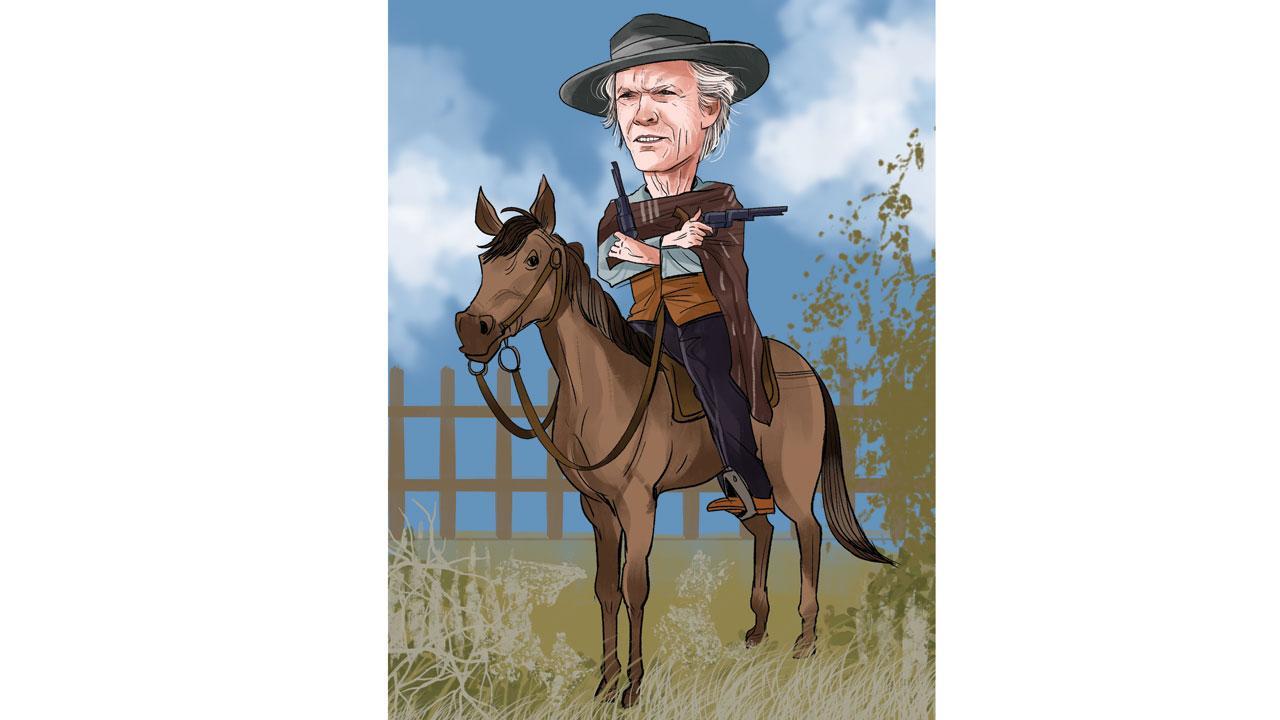Sean Penn once said of the man, “he likes absolute silence on set, probably comes from his years of working with horses.”

Illustrations/Uday Mohite
 Don’t let the old man in
Don’t let the old man in
I wanna leave this alone
Can’t leave it up to him
He’s knocking on my door
And I knew all of my life
That someday it would end
Get up and go outside
Don’t let the old man in
Many moons I have lived
My body’s weathered and worn
Ask yourself how would you be
If you didn’t know the day you were born
—Toby Keith
As the end credits roll in Clint Eastwood’s 2018 film, “The Mule”, country singer Toby Keith’s Don’t Let The Old Man In’ plays—the film is about an old man, who successfully runs drugs across the US, a second chapter in his life.
ADVERTISEMENT
In every way, the song could be about Clint Eastwood who turned 94 two days ago—still fully functional, still fully lucid, still utterly creative, 65 motion pictures in his filmography (35 directed).
In my view, there are two phases in Eastwood’s hugely fertile career, pre his 2003 Mystic River and post that.
In the first half, 1963 till 2003, there seemed to be a passion for, an obsession with the “tough guy”—scowling cowboys puffing on cheroot cigars in Sergio Leone’s spaghetti westerns, and hard-nosed, gun-toting detectives like Dirty Harry.
It was guns and glory, holsters and hard talking in that phase, as Eastwood “made most days hell for the baddies”.
History was made with the Good, the Bad and the Ugly, and the Dirty Harry series, culminating in 1992’s The Unforgiven.
But from 2003 to the present he’s made 17 motion pictures, aged 74 to 94, with themes as varied as Man vs Nature, Christian guilt, the loss of innocence and death as a part of life--he began with “Mystic River”, a noir crime thriller, based on a Dennis Lehane book, his film making skills hitting new deeper levels—his direction of Sean Penn and Tim Robbins, childhood friends torn apart by a terrible incident, won them Best Actor and Best Supporting Actor at the 2004 Oscars.
Sean Penn once said of the man, “he likes absolute silence on set, probably comes from his years of working with horses.”
“Million Dollar Baby” was followed by one of the greatest achievements in modern film making—in 2006, Eastwood simultaneously shot two war dramas, “Flags of our Fathers” and “Letters from Iwo Jima”--the former in English, the latter in Japanese—to show audiences the two opposing viewpoints.
Matt Damon, who worked with him in the rugby sports film, “Invictus” said with some awe and respect, “He likes one, maximum two takes per shot” —”let’s not waste everyone’s time”, Eastwood once famously said.
It’s true that Clint Eastwood has maintained amazing fitness all through his life, with exercise and diet control.
But what creates such an attitude of inner well-being and outer drive, at an age when most men are winding down, for the most prolific period in his life is perhaps a never ending hunger to make films. He has acted in many of these, anyone who’s made a film, will tell you how hard it is to do both, the level of detail you need, the trust you repose with your cinematographer, perhaps why Tom Stern has shot most his films—much-detailed home work, and trust in your cameraman, allows him to perform freely.
It wouldn’t be fair to say he is one of Hollywood’s greatest actors. But being an actor, gives him his ability to extract the finest performances from his actors.
As Eastwood said of his later career, “Everybody wonders why I continue working at this stage. I keep working because there’s always new stories. And as long as people want me to tell them, I’ll be there doing them”.
Perhaps most importantly, he’s never let the old man in. Never.
Rahul daCunha is an adman, theatre director/playwright, photographer and traveller. Reach him at rahul.dacunha@mid-day.com
 Subscribe today by clicking the link and stay updated with the latest news!" Click here!
Subscribe today by clicking the link and stay updated with the latest news!" Click here!







